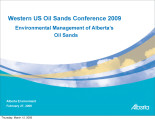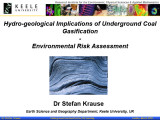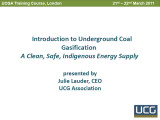TO
Filters: Collection: "ir_eua"
| Title | Date | Subject | Description | ||
|---|---|---|---|---|---|
| 1 |
 |
APPENDIX E - Integrated treatment of produced water by chemical and biological unit operations, A subpart of project - Quantifying water availability impacts and protecting water quality while developing Utah oil shale and sands - Final Project Report - Reporting period: June 21st, 2006 to October 21st, 2009 | 2010-10-07 | Water treatment; Water quality - Utah; Oil shale and sands | Water generated along with oil, gas, and coal bed methane production is commonly known as produced water, formation water, or oilfield brine [1]. Produced water represents the largest waste stream volume in production operations on most offshore platforms [2]. According to the American Petroleum Ins... |
| 2 |
 |
Heavy-oil resources of the United States | 1995 | heavy-oil resources; United States; petroleum; heavy oil | Petroleum is considered to originate from marine and terrestrial organic matter (composed principally of hydrogen and carbon) buried along with sediment. The organic molecules are eventually broken by thermal stress encountered during progressive burial. The product of this heating can be liquid and... |
| 3 |
 |
Influence of biodegradation on the chemical composition of heavy oil and bitumen | 1987 | biodegredation; chemical composition of heavy oil and bitumen; heavy oil; bitumen; biodegredation of petroleum | Biodegradation of petroleum is a selective metabolism of special organic compounds by an ensemble of microorganisms. It apparently starts under aerobic conditions, which are provided in areas invaded by surfacederived, oxygen-rich formation waters. Bacteria introduced into an oil pool with meteoric ... |
| 4 |
 |
Environmental management of Alberta's oil sands | 2009-02-27 | environmental management; oil sands; Canadian oil sands development; crude bitumen; mineable resources; in situ resorces; oil sands deposits | Analysis of the challenges and successes of environmental management of Canadian oil sands development, presented at the 2009 Western U.S. Oil Sands Conference by Preston McEachern, Head of Science, Research & Innovation, Oil Sands Environmental Management Division, Alberta Environmental, Canada. |
| 5 |
 |
Hydro-geological implications of Underground Coal Gasification: Environmental risk assessment | 2011-03-21 | hydro-geological implications; underground coal gasification; UCG; environmental risk assessment; hydrological processes; hydrochemical processes | UCG Training Course, March 21-22, 2011, Deloitte, London |
| 6 |
 |
Summary of air quality regulations and recommended guidelines for oil shale development in the Colorado Piceance Basin | 1982-02 | air quality regulations; oil shale development; Colorado Piceance Basin; domestic fuel; shale oil | The Piceance Basin of northwestern Colorado contains the greatest domestic concentration of oil shale deposits favorably located for economical recovery. These deposits are defined geologically to be at least 30-ft thick with at least 30 gal of oil per ton of shale; by conservative estimate, they co... |
| 7 |
 |
Draft environmental impact statement on conversion of oil and gas leases to combined hydrocarbon leases, Tar Sand Triangle, Utah | 1984-07-16 | The Draft Environmental Impact Statement will provide the Regional Director, National Park Service, and State Director, Bureau of Land Management, with the necessary information to make a decision on whether existing oil and gas leases in Glen Canyon National Recreation Area and on adjacent BLM land... | |
| 8 |
 |
Policy analysis of the Canadian oil sands experience-Topical Report | 2013-09 | Topical Report; Oil & Natural Gas Technology; October 1, 2009-September 30, 2014; Canadian Oil Sands; Policy; Subtask 6.2 | For those who support U.S. oil sands development, the Canadian oil sands industry is often identified as a model the U.S. might emulate, yielding financial and energy security benefits. For opponents of domestic oil sands development, the Canadian oil sands experience illustrates the risks that oppo... |
| 9 |
 |
Introduction to Underground Coal Gasification: A Clean, Safe, Indigenous Energy Supply | 2011-03-21 | underground coal gasification; energy supply; UCG; UCG technology development | UCG Training Course, March 21-22, 2011, Deloitte, London |
| 10 |
 |
Pressurized ozone treatment of produced water and pressurized hot water extraction of bitumen from oil sands | 2008-02-22 | pressurized ozone treatment; produced water; pressurized water extraction; bitumen extraction; oil sands; treatment technologies; synthetic produced water; real produced water; ozonization. | |
| 11 |
 |
Environmental, health, safety, and socioeconomic impacts associated with oil recovery from tar-sand deposits in the United States | 1981-09-12 | tar sand; tar sand resources; oil recovery; petroleum extraction | The tar-sand resources of the United States have the potential to yield as much as 36 billion barrels (bbls) of oil. The tar-sand petroleum-extraction technologies now being considered for commercialization in the United States include both surface (above-ground) systems and in situ (underground) pr... |
| 12 |
 |
Spent shale grouting of abandoned in-situ oil shale retorts | 1980-03 | spent shale grouting; in-situ oil shale retorts; abandoned oil shale retorts; vertical modified in-situ oil shale retorting; VMIS; retort abandonment | In vertical modified in-situ (VMIS) oil shale retorting, the resource is processed in the ground. Large chambers of rubblized oil shale are formed by mining out about 20 to 40 percent of the in-place shale and blasting the balance into the created void. The mined-out material is brought to the surfa... |
| 13 |
 |
Treatment of produced water by pressure-assisted ozonation and sand filtration | 2009 | produced water; pressure assisted ozonization; sand filtration; energy production; heavy petroleum sources; oil sands | Ever increasing energy demand worldwide necessitates energy production from heavy petroleum sources such as oil sands and oil shale. Extraction of bitumen from oil sands and in situ extraction of kerogen from oil shale result in large quantities of water containing hydrocarbon contaminants. The cont... |
| 14 |
 |
Los Alamos environmental activities/oil shale effluents | 1985-07 | oil shale effluents; oil shale resource; Los Alamos; health and environmental issues | Complex health and environmental issues will affect both the extent and rate of development of the nation's oil shale resource. Among these issues are concerns about land disruption, air and water contamination, waste disposal, and health and environmental problems associated with the refining and u... |
| 15 |
 |
Survey of geologic research on Green River oil shale | 1977 | Survey; geologic research survey; geologic survey; oil shale deposits; Green River oil shale; mineral deposit study | In the last decade, geologic research on oil-shale deposits and associated rocks of the Green River Formation in Colorado, Utah, and Wyoming has mushroomed largely in response to the Department of the Interior's oil-shale leasing program and to the active interest of private and governmental groups ... |
| 16 |
 |
Utah Heavy Oil Program - Final Scientific/Technical Report - Project Period: June 21, 2006 to October 20, 2009 | 2010-01-31 | Utah heavy oil program; heavy oil; UHOP; developing heavy oil resources; oil sands resources; oil shale resources | The Utah Heavy Oil Program (UHOP) was established in June 2006 to provide multidisciplinary research support to federal and state constituents for addressing the wide‐ranging issues surrounding the creation of an industry for unconventional oil production in the United States. Additionally, UHOP w... |
| 17 |
 |
Research and information needs for management of tar sands development | 1983 | tar sands management; research needed; tar sands | The purpose of this report is to review the research needed to support the regulatory and managerial role of the agencies in the development of tar sands resources. The material reviewed in preparation for this report was assembled and presented at the Workshop on Research Needs for the Management o... |
| 18 |
 |
Control strategies for abandoned in situ oil shale retorts | 1979-04 | In situ oil shale retorting may result in a number of environmental impacts including degradation of local surface and groundwaters, low resource recovery and subsidence. The target of present oil shale commercialization activities is the Mahogany zone in Colorado's Piceance Creek Basin. The princip... | |
| 19 |
 |
Land and resource management issues relevant to deploying in-situ thermal technologies: Topical Report: October 1, 2009 to December 31, 2010 | 2011-01 | in-situ; oil shale; domestic energy source; oil sands | Utah is home to oil shale resources containing roughly 1.3 trillion barrels of oil equivalent and our nation's richest oil sands resources. If economically feasible and environmentally responsible means of tapping these resources can be developed, these resources could provide a safe and stable dome... |
| 20 |
 |
America's oil shale: A roadmap for federal decision making | 2004-12 | Oil shale resources; Oil supply; U.S. economy; Domestic oil shale; Oil production; Multi-agency Federal oil shale plan; Energy; Interior; Defense; Treasury; America; Import dependence; Natural gas by-products; Oil price; Oil supply and demand | The President and the Department of Energy have determined that increasing liquid fuels supply from domestic sources is an important national objective. America's rich and concentrated oil shale resources, containing as much as 2 trillion barrels of potential oil supply could make a major contributi... |
| 21 |
 |
Inventory of Sunnyside Tar Sands data: Located at the Utah Geological Survey | 2004-05-18 | Sunnyside Tar Sands data; Utah geological survey | |
| 22 |
 |
A technical, economic, and legal assessment of North American heavy oil, oil sands, and oil shale resources: In response to Energy Policy Act of 2005 Section 369(p) | 2007-09 | Oil sands; Oil shale; Heavy oil; Energy Policy Act; 2005; Climate Change; Petroleum; Oil Cost; United States; North American heavy oil; Utah Heavy Oil Program; UHOP; World economic development; Energy; Canadian oil sands; Unconventional resources ;Technical; Economic; Legal assessment | Against the backdrop of world population growth, rapid economic expansion in the world's most populous countries, challenging political climates in many oil-producing nations, and the specter of climate change, worldwide energy consumption is projected to increase from the 2004 level of just over 40... |
| 23 |
 |
Sources and deposition of organic matter in the Monterey Formation, South-Central Coastal basins of California | 1987-11-02 | organic matter; Monterey Formation; Californial ; marine algal debris | The abundant organic matter in the Monterey Formation is commonly considered to be derived from marine algal debris rapidly deposited in anoxic bottom water during a period of high surface plankton productivity. However, many aspects of the distribution of organic matter in the Monterey of the south... |
| 24 |
 |
Porosity modification related to tar sand process water | 1988-08 | porosity modification; tar sand process water; tar sand; petroleum recovery; oil resource; tar sand production; bitumen production | Laboratory experiments were conducted to determine the effects of tar sand process water on the mineral components of a sandstone from a known tar sand deposit and on control samples of feldspars of varying compositions. Contact with the process water increased porosity and permeability in the test ... |
| 25 |
 |
Geology and geochemistry of Santa Rosa tar sands | 1987-11-02 | Santa Rosa tar sands; tar sands; heavy oil deposits; Triassic Santa Rosa Sandstone | Heavy oil deposits 11 km (7 mi) north of the town of Santa Rosa, Guadalupe County, New Mexico, in the Triassic Santa Rosa Sandstone, were mined during the 1930s. Renewed interest in this deposit in the late 1970s so far has not resulted in exploitation because of unfavorable economics and the encroa... |
